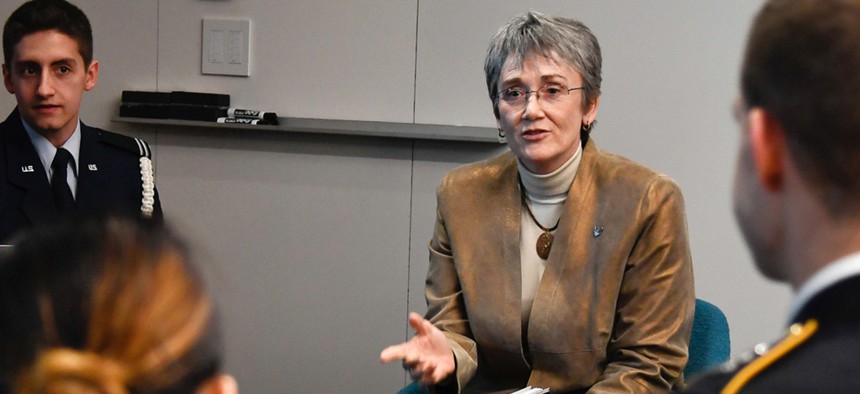
Secretary of the Air Force Heather Wilson speaks to Air Force cadets at Northeastern University in Boston April 4. Mark Herlihy/USAF
Here’s How the USAF Is Using Its New Purchasing Power
Next week, program heads will meet at the Pentagon to brief the service’s new acquisition board of directors.
Air Force Secretary Heather Wilson has a new role: chairman of the board.
Now that Congress has largely put the services in charge of buying weapons, and removed much of the purview of the Office of the Secretary of Defense, Wilson has put in place a new governing body to oversee hundreds of billions of dollars in purchases. The panel will meet for the first time next week.
“We’re going to try to be managing more at the strategic level,” Wilson said Monday during a taping of Defense One Radio. (The interview begins at the 12:57 mark in the clip below)
That board is made up of Wilson; Gen. David Goldfein, the Air Force chief of staff; Undersecretary Matt Donovan; and Will Roper, the service’s assistant secretary for acquisition, technology and logistics. The panel will meet three times a year and receive briefings from a dozen or so program executive officers. Each of those senior acquisition officials oversees numerous projects.
Right now, the meetings are dubbed “Air Force Acquisition Day,” which Wilson acknowledges isn’t the best name. “It’s more like a corporate board meeting than it is a small business meeting,” she said.
In all, Wilson is now responsible for 465 major programs. Her goal is simple: get capabilities to airmen faster and cheaper.
“We don’t want to just replicate a bureaucratic system that we just managed to get out from under where nobody’s really accountable, but everybody gets a chance to check off on everything,” she said. “That slows things down and it adds cost.”
Program managers — the officials who actually run projects day-to-day — are being “encouraged to seek help quickly rather than wait until a program is way of track,” Wilson said. These program officials will no longer need to seek “everybody in the Pentagon to move forward on the next step of their projects,” the secretary said. “They are going to be accountable for results: cost, schedule and performance.”
“I want them spending more time managing the programs than managing the Pentagon,” Wilson said.
Buying new software is among the items Air Force leaders plan to discuss at next week’s meeting.
“When we looked at all our programs last year, and which ones were struggling, there was a common theme,” Wilson said. “Almost all of them were having problems because of software problems. The Defense Department doesn’t buy software well.”
Another possible agenda item: “how we innovate in sustainment, ” acquisition head Roper said at a briefing last month.
Speaking more generally about her plans for changing the way the Air Force buys weapons, Wilson said to expect more prototyping and experimentation, akin to work already being done by Pratt & Whitney and General Electric to build new jet engines. The goal of the project is to increase fuel efficiency by 25 percent and thrust by 10 percent. These new engines could one day replace existing fighter jet engines.
“Instead of trying to do an engineering design and sit down with modeling and simulation and all of that for two or three years, which is what the normal acquisition process would do, we contracted with two of the best engine companies in America and said: ‘See what you can build,’” Wilson said.
“Maybe they’ll get to 24 percent. Maybe they’ll tell us where the constraints are and then we’ll start to set — based on those real experiments, those prototypes — what we want to accomplish in our next-generation engine. But we’ll have real engines and real data. The Air Force and the Defense Department historically has not been allowed to do that kind prototyping.”
To put the potential savings in perspective, the Air Force plans to spend about $5 billion on fuel this year.
“If you get an aircraft whose range is is 1,000 miles and you can get a 25-percent increase in fuel efficiency, what does that do for the tankers you need, or for the targets you can reach,” Wilson said. “That’s a big deal.”




